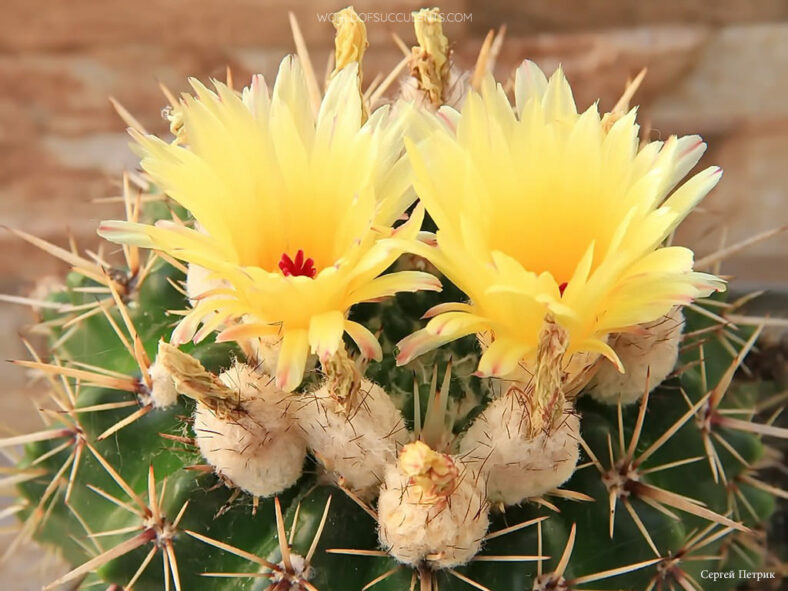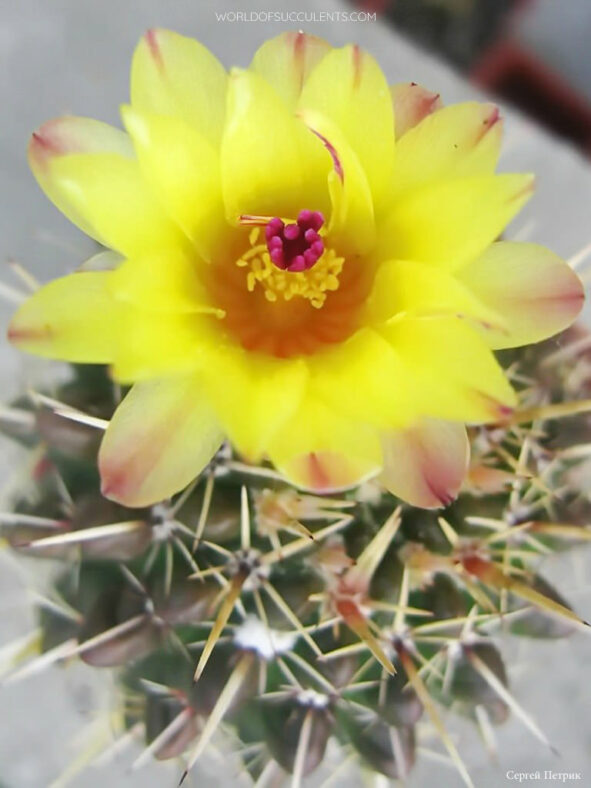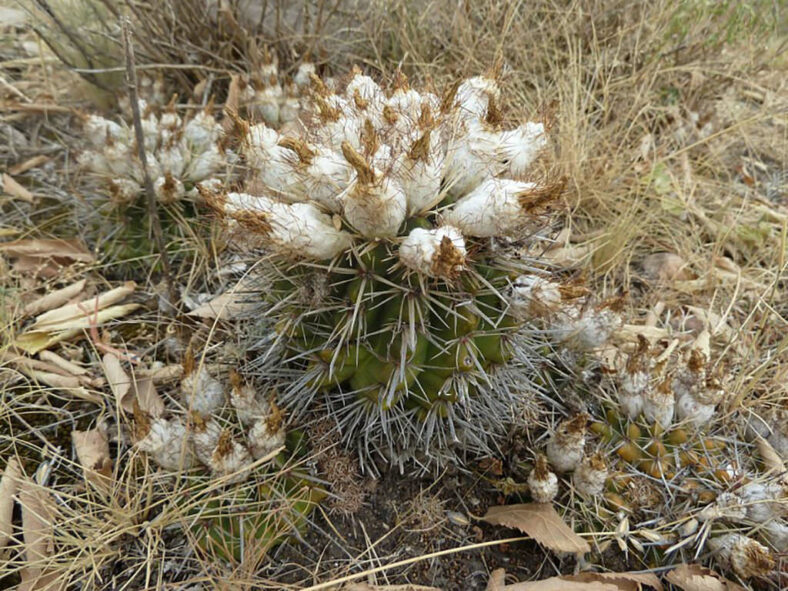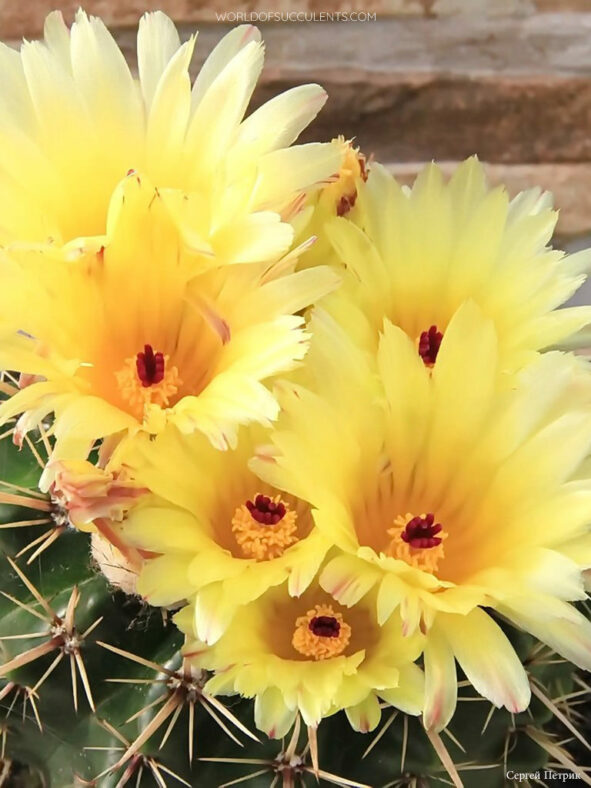Parodia mammulosa subsp. submammulosa is not recognised as a separate subspecies and is treated as a synonym of the highly variable Parodia mammulosa.
Scientific Name
Parodia mammulosa subsp. submammulosa (Lem.) Hofacker
Accepted Scientific Name
Parodia mammulosa (Lem.) N.P.Taylor
Synonym(s)
Echinocactus mammulosus var. submammulosa, Echinocactus submammulosus, Notocactus submammulosus, Parodia submammulosa, Ritterocactus mammulosus subsp. submammulosus
Scientific Classification
Family: Cactaceae
Subfamily: Cactoideae
Tribe: Notocacteae
Genus: Parodia
Etymology
The specific epithet "submammulosa (pronounced sub-mam-yoo-LOH-suh)" means "nearly mammulosa" and refers to the distinct shape and spination of this cactus in comparison to the typical form.
Origin
Parodia mammulosa subsp. submammulosa is native to Brazil, Argentina, and Uruguay. It grows in grasslands with rocky outcrops ranging from 330 to 5,900 feet (100 to 1,800 m) above sea level.
Description
Parodia mammulosa subsp. submammulosa, formerly known as Notocactus submammulosus, is a small cactus that grows slowly and has a solitary, spherical stem with about 13 strongly tuberculate ribs lined with clusters of spines. The stem is greyish-green to dark green and can reach a diameter of 4 inches (10 cm). The areoles are felted and located between the tubercles, each bearing about six radial and two central spines ranging from white and yellow to brown with a dark brown tip. The radial spines are needle-like and spreading, measuring up to 0.4 inches (1 cm) long, while the central spines are flat, with one pointing upward and one longer pointing downward, measuring up to 0.8 inches (2 cm) long.
In spring and early summer, Parodia mammulosa subsp. submammulosa produces beautiful flowers at the top of the stem. The funnel-shaped flowers can reach up to 1.8 inches (4.5 cm) in diameter and have golden yellow tepals and red or wine-colored stigma lobes. The fruits are barrel-shaped, covered with white to brownish wool and several dark bristles, and contain green pulp and numerous brown seeds.

How to Grow and Care for Parodia mammulosa subsp. submammulosa
Light: Generally, Parodia mammulosa subsp. submammulosa can handle direct sun in the morning and afternoon, but it prefers partial shade during midday. So, place the plant outdoors anywhere it can receive bright, indirect sunlight. When growing indoors, choose a sunny windowsill and rotate the pot every two weeks to encourage balanced growth. However, move it outdoors in the spring, if possible.
Soil: Soil with good drainage is crucial for a healthy plant. Therefore, use commercial soil for cacti or make your own well-draining mix with mineral grit such as coarse sand, perlite, or pumice.
Hardiness: This cactus thrives in warm, desert-like conditions but will not survive a hard frost. So, if there is a risk of freezing temperatures, it is best to plant it in a container that can be brought indoors. Parodia mammulosa subsp. submammulosa grows best in USDA Plant Hardiness Zones 9b to 11b, with average minimum winter temperatures ranging from 25 to 50 °F (-3.9 to 10 °C).
Watering: During the growing season, water deeply, but allow the soil to dry out to the touch between waterings. When it goes dormant during the winter, the plant needs much less water than usual. Therefore, water sparingly.
Fertilizing: While not necessary, Parodia mammulosa subsp. submammulosa will respond well to a low-balanced soluble fertilizer diluted to half the recommended strength. However, suspend feeding in winter.
Repotting: If growing this cactus in a container, repot as needed from spring to early summer, but ensure the soil is dry before you start, and always pot it in a container with drainage holes.
Propagation: Since it rarely produces offsets, Parodia mammulosa subsp. submammulosa is usually propagated by seeds. For best results, sow the seeds in spring.
See more at How to Grow and Care for Parodia.
Toxicity of Parodia mammulosa subsp. submammulosa
Parodia mammulosa subsp. submammulosa is non-toxic to humans or animals.
Links
- Back to genus Parodia
- Succupedia: Browse succulents by Scientific Name, Common Name, Genus, Family, USDA Hardiness Zone, Origin, or cacti by Genus
Photo Gallery
Click on a photo to see a larger version.


